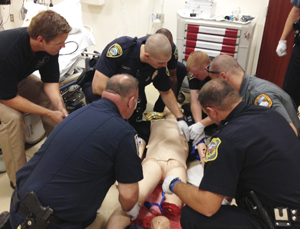The West Hartford Police Department in Connecticut trains police officers, members of the military and firefighters in how to assist critically injured members of the public and other emergency responders, and in how to provide self-care if injured or wounded.

Emergency responders practice field trauma response on a medical simulator during training offered by the West Hartford Police Department's tactical and protective medicine branch.
The department's tactical and protective medicine branch has provided such training for years. Members of its SWAT team — a physician, medics and active Navy SEALs specially trained in how to provide tactical medical care — conduct training sessions for hundreds of military members and emergency responders each year, explained West Hartford Officer Brian Wallace, who founded and coordinates the branch. Tactical medicine is the practice of emergency medicine in the field during disasters, conflicts or under other life-threatening conditions.
Instruction and content are tailored to the group or team being trained. For instance, in a two-day Police Combat Lifesaver Course, participants spend one day in Hartford Hospital's Center for Education, Simulation and Innovation, a simulation lab, and the other in scenarios training for events like an active shooter or bombing situation. Participants learn how to control massive hemorrhage, clear an airway, ventilate a patient and treat penetrating and blast trauma —injuries that may be caused by gunfire or explosive devices.
The Hartford Consensus (see main story) advocates for members of the public to be trained in hemorrhagic bleeding control techniques, too, but the West Hartford police "have not branched out to civilian training," said Wallace. He thought it likely that the training of civilians in bleeding control techniques might be added to existing training, such as first-aid courses for the public.
He said members of his department have carried commercially made tourniquets for several years, adding that the basics of how a commercially made tourniquet should be applied can be taught in about 10 minutes.
Copyright © 2014 by the Catholic Health Association
of the United States
For reprint permission, contact Betty Crosby
or call (314) 253-3477.